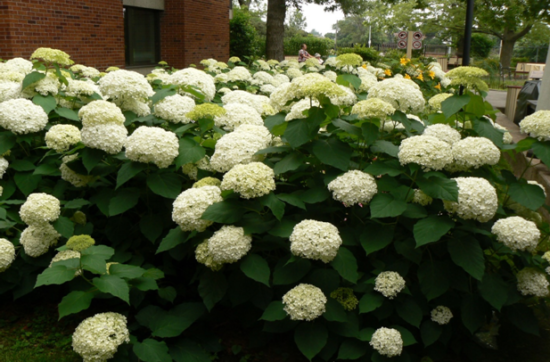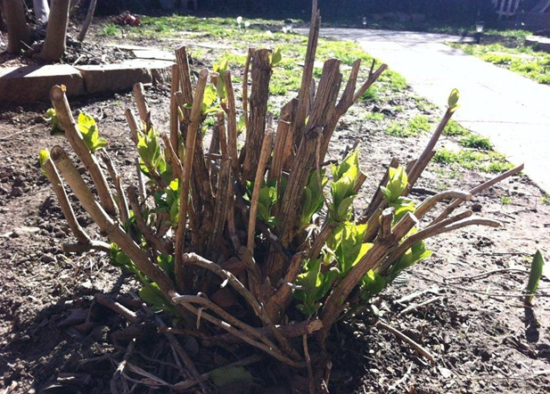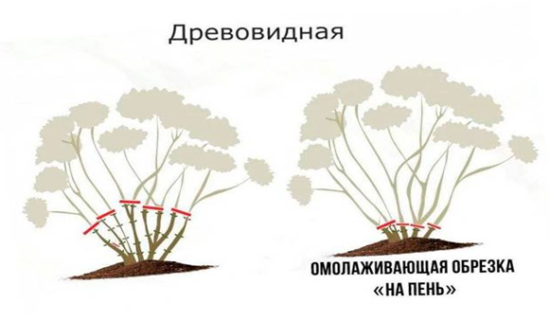Tree hydrangea pruning
Tree hydrangea (Hudrangeaarborescens) is a perennial shrub, up to 3 m high. It is grown everywhere due to its extreme unpretentiousness. Adapted to harsh winters, tolerates both sunny and partial shade places. For its decorativeness and lush flowering from June to October, it has acquired an army of fans around the world.
| Content:
|
|
Hydrangea tree Strong Anabel in bloom |
By pruning you can regulate the growth of the plant, the size of the inflorescences, and shape the height and width of the seedling. During the growing season, the crop produces a lot of shoots, which makes pruning an important component of agricultural technology.
Rules for pruning tree hydrangea
Neglecting the procedure, the abundance of zero shoots growing from the ground will turn the bush into a shapeless accumulation of branches with small, inconspicuous inflorescences. In this state, the plant suffers from excessive density, loses strength and decorativeness, and ages quickly.
Important! Pruning is carried out with a tool with narrow, disinfected, sharp blades. The tapered ends will provide free access to the inside of the bush. The cut is made at an angle of 45°, 1-2 cm above the healthy kidney.
When is the best time to prune tree hydrangea, in spring or autumn?
In spring, it is better to carry out only sanitary pruning, if necessary. Autumn pruning is recognized as the most effective.
Reasons for unwanted spring cleaning:
- With the end of winter, the crop's vitality awakens and powerful sap flow is activated. If you make a haircut, the seedling will begin to cry with drops of precious juice, which it needs for full growth. The culture loses some of its energy, meeting the new season of its life weakened.
- Open cuts on shoots are a direct path for the penetration of various pathogens and bacteria. There is a high risk of contracting an infection at the very beginning of the season.
At what year after planting should pruning begin?
The first pruning of tree hydrangea is done no earlier than 5-6 years after planting. Before this, only the faded inflorescences are cut off at the tops. The plant should not be disturbed ahead of time; it needs to gain strength.
Early pruning has a negative impact on the development of the crop. The seedling weakens, slowly grows shoots, and blooms sparingly.
If the green pet is more than five years old, pruning begins. There is no need to be afraid of doing something wrong the first time and cutting off excess. Tree hydrangea blooms both on the current year's shoots and on last year's shoots, and will quickly recover.
Don't forget to read:
Pruning tree hydrangea in spring
If the crop was pruned in the fall according to all the rules, it is better not to injure it at the end of winter. Inspect the plant and, if necessary, begin sanitary pruning. Broken, dry, diseased, crooked branches, and frozen shoots must be removed.
|
Overwintered bush, properly decorated in autumn |
Attention! Any spring pruning is carried out strictly before the start of sap flow, otherwise the hydrangea will lose vital nutrition.
Scheme for pruning tree hydrangea in autumn
The procedure is carried out on the eve of winter, as late as possible, when the hydrangea completely sheds its leaves and goes into hibernation. The timing depends on the region of growth. In the central zone of the Russian Federation this is the end of October-beginning of November, in the south a little later, in zones with a harsh climate a little earlier.
If you prune in early autumn, the plant experiences stress: it loses its juices, the growth of young shoots is activated, which, without having time to get stronger, will freeze out in the winter.
The procedure consists of several stages:
- Sanitary pruning. At ground level, shoots with faded inflorescences of the current year are cut out. Old, dry shoots are removed. You can identify them if you sharply lift the branches up. A characteristic crunch will be heard. These will be the stems to be destroyed. Broken, crushing shoots, as well as branches growing inward, are removed.
- Thinning the shoots. The plant produces many secondary branches. When rationing, small growth, flimsy, thin stems are cut off. There is no need to feel sorry, they are unlikely to bloom next year, they will only draw extra strength from the queen cell.
- Rejuvenating. For the purpose of rejuvenation, the tree-like hydrangea is “planted on a stump”, completely cutting off all the shoots just above the first bud.
- Pruning for flowering (formative). Involves shortening of shoots. They are pruned, guided by the rule - the lower the pruning, the later the bush begins to flower, but it produces large caps of inflorescences.
Thick (pencil-sized or more) stems from last year and young shoots are left behind. If you want to get a late wave of flowering with huge inflorescences, leave 1-2 buds on the stem and cut off the rest. This low pruning involves installing supports under the branches. The flower stalks will grow large, and under their weight the shoots will begin to bend to the ground.
If you leave 3 or more buds, the bush will stretch upward and bloom in early July. The top will be like a ball, all covered with panicle inflorescences, but they will turn out to be modest in size.
Shoots growing on the left skeletal branches are shortened by a third.
Combined pruning
This pruning is done in two ways at the same time. Cut off older shoots by 1/3, new stems by 2/3. In this case, the crop will bloom at different times, blooming gradually. The result will be cascading, multi-level flowering.
|
Well-formed hydrangea with strong shoots for flowering |
With proper full autumn pruning, 6-10 strong shoots remain, half of which are shoots from last year.
Important! After the operation is completed, the plant becomes vulnerable to pests, pathogens of dangerous diseases, and fungi. All cuts must be covered with garden varnish or powdered with ash. Manipulations will prevent unwanted guests from entering through open wounds.
Video clip of pruning tree hydrangea in autumn:
Autumn pruning has many positive aspects:
- Eliminates the risk of damage to shoots from the weight of snow.
- Larvae of harmful insects, fungal spores, and diseases are neutralized. The cut parts must be burned.
- The roots receive more nutrition and moisture, and their resistance to frost increases.
- The procedure provokes active growth of young shoots with the arrival of spring.
- Facilitates the process of preparing for winter and sheltering for the winter.
How to perform anti-aging pruning
If there are mature bushes on the site that have never been pruned, as well as old, diseased plants, a radical rejuvenation procedure must be carried out.
The disadvantage of pruning “to the stump” is that you should not expect flowering next year. The green pet will begin to actively accumulate strength for growth. For this reason, they try to avoid drastic cutting by carrying out thinning and shaping trimming in a timely manner.
Complete rejuvenation is carried out in late autumn, after the end of sap flow:
- First, sanitary cleaning is carried out, removing broken, dry, diseased, crooked, and small shoots.
- Zeros, growing from the ground and not having the strength to flower, are cut out “to zero.”
- All remaining shoots from the past and current season are cut off completely, leaving 1-2 buds from the ground.
- The sections must be sealed with garden varnish or powdered with ash or crushed activated carbon.
- In a year, a healthy, restored strong bush will produce abundant, powerful flowering on strong, strong shoots.
|
Scheme of formative and rejuvenating pruning of tree hydrangea |
Preparing tree hydrangea for winter
They begin to prepare the seedling for wintering in mid-autumn:
Remove fallen leaves; they can become a source of rotting and proliferation of pathogenic bacteria. Complex phosphorus-potassium fertilizer is scattered under the stems. It will help you prepare for the cold and endure severe frosts.
When a plant goes into hibernation, it must be saturated with moisture. 2-3 buckets of water are poured under the root. The liquid will dissolve the applied fertilizers, deliver nutrients to the roots, and saturate the seedlings with moisture.
Most varieties of tree hydrangea do not need shelter. However, light hilling and an additional layer of mulch will protect the root system from the cold.
After late autumn pruning, the remaining branches of an adult bush are tied into a bundle with a rope. The root part is covered with a thick layer of acidic peat, pine and pine litter. Such a shelter will prevent the soil from freezing before the snow falls and will protect the roots from the cold. In spring, mulch will serve as an additional soil acidifier. As it decomposes, it will loosen the soil and saturate it with useful micro and macroelements.





 CUCUMBERS NEVER GET SICK, I'VE BEEN USING ONLY THIS FOR 40 YEARS! I SHARE A SECRET WITH YOU, CUCUMBERS ARE LIKE THE PICTURE!
CUCUMBERS NEVER GET SICK, I'VE BEEN USING ONLY THIS FOR 40 YEARS! I SHARE A SECRET WITH YOU, CUCUMBERS ARE LIKE THE PICTURE! You can dig a bucket of potatoes from each bush. Do you think these are fairy tales? Watch the video
You can dig a bucket of potatoes from each bush. Do you think these are fairy tales? Watch the video
 How our fellow gardeners work in Korea. There is a lot to learn and just fun to watch.
How our fellow gardeners work in Korea. There is a lot to learn and just fun to watch. Eye trainer. The author claims that with daily viewing, vision is restored. They don't charge money for views.
Eye trainer. The author claims that with daily viewing, vision is restored. They don't charge money for views. A 3-ingredient cake recipe in 30 minutes is better than Napoleon. Simple and very tasty.
A 3-ingredient cake recipe in 30 minutes is better than Napoleon. Simple and very tasty. Therapeutic exercises for cervical osteochondrosis. A complete set of exercises.
Therapeutic exercises for cervical osteochondrosis. A complete set of exercises. Which indoor plants match your zodiac sign?
Which indoor plants match your zodiac sign? What about them? Excursion to German dachas.
What about them? Excursion to German dachas.